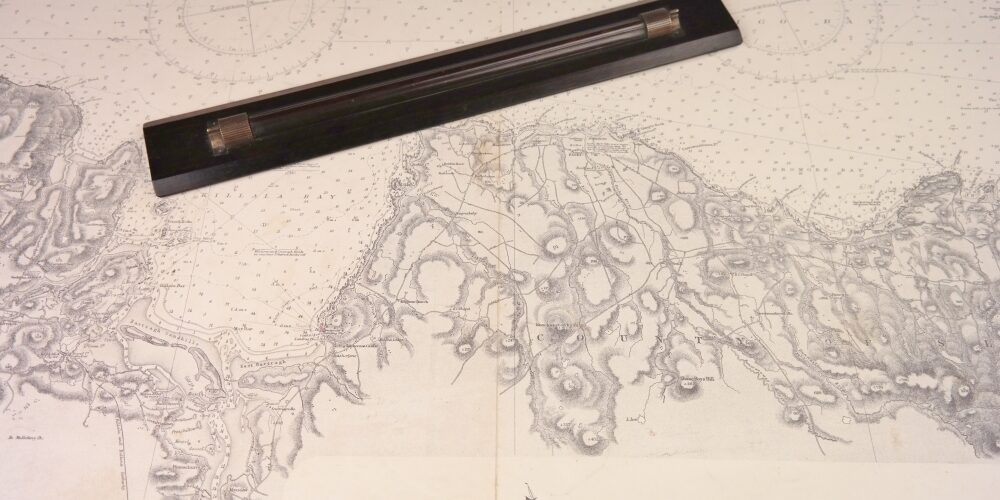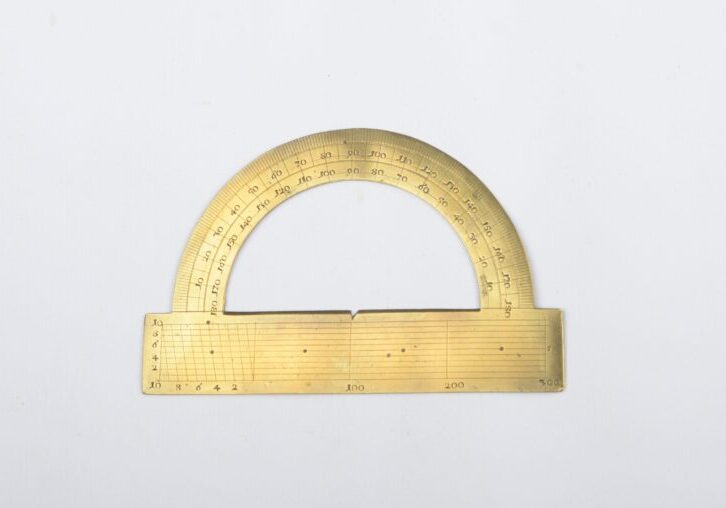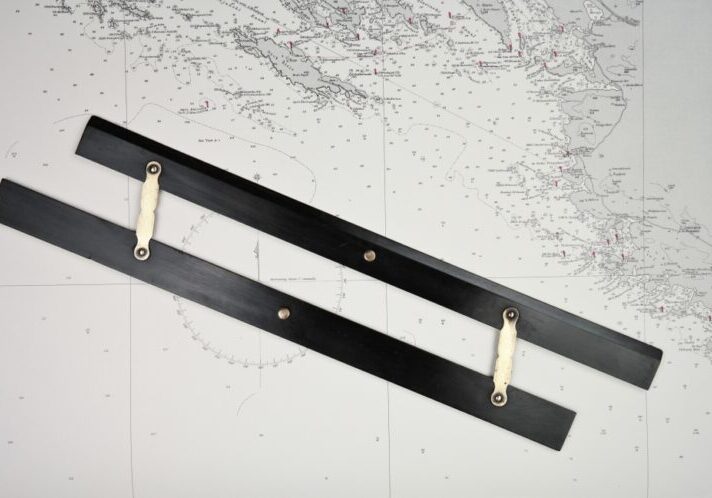Nautical instruments
This part of the collection includes mainly navigational instruments from the early sailing period, the time when ships were made of wood and men were made of steel.
Positions of celestial bodies are indicated by height above the horizon and by azimuth. The direction of a celestial body to be observed can be determined with the help of an azimuth ring.
An azimuth ring like this is placed on the compass and is rotated in the direction of the celestial body to be observed. With the help of the rotatable prism, both the celestial body and the compass rose are observed. In this way the direction is determined in which the celestial body is located. Sunshades are available for sun observations. Land objects can also be observed with it.
This Azmuth ring looks brand new. Both the case and the instrument do not seem to be used in practice. Even the Langford sales label, in the form of a cardboard compass rose, is still glued to the circle.
The ring is marked: Gyro Azimuth circle. Serial nr. R/78/RML/224. In the lid instructions for use.
Catalog: NM. 4-16
Date: ca. 1950
HWL case: 14x29x29 cm (5.5×11.5×11.5 in)
Diam. circle: 10 in
Signed on the label: Langford, 53 Quay, Bristol
Origin: England
Condition: excellent
Brass ruler with different proportional scales and nautical chart divider in a leather case.
All three are in good condition.
On the ruler the scales:
Meters 1:1000 and 1: 2500.
Meters to Pied de Chamb.
Vadems of Savoy 1: 2372
Meters 1: 2372
Catalog: NM.4-15
Date: ca. 1800
L: 20 cm (7.9 in)
Signed: not signed
Origin: French
Condition: very good
Eigtheen century brass protractor with hand engraved scales and transversal nonius on the horizontal bar.
Catalog: NM.4-12
Date: 1790-1810
HW: 71×113 mm
Signed: not signed
Origin: France
Condition: excellent
A ship-log records the distance travelled through the water. With the time in hours between the observations, it gives the ship’s speed in knots.
This is a nice set with clock, line, rotator, sinker weight and towing ring in a pine case with instruction for use in the lid. The log is fixed at the stern of a ship with a rope. The recorder would have been connected with a line to the rotor at the end of the line. Open govenor wheel is mounted on a drive spindle. The enamel face with two dials.
Thomas F. Walker (1837–1921) patented a log in 1878, the Walkers patent taffrail ship-log. It was one of the first logs in which the recorder was placed on board the ship rather than being part of the rotator. The Excelsior Mark III was made between 1926 and 1936.
Catalog: NM.4-8
Date: ca. 1926-1936
HWD case: 13x40x17 cm (5.1×15.7×6.8 in)
Signed: Walker’s Mark III Excelsior Yacht-log, nr Q4270
Origin: England
Condition: complete, in good and working condition, wear consistent with age and use
Pelorus in a remarkable wooden suit-case with brass handle. The suit-case is made of lime-wood and marked with a crown and number 28.
The pelorus has to be slid onto a shoe on the railing to take relative bearings. The instrument is made of brass, the rose appears to be silver-plated.
Catalog: NM.1-29
Date: ca. 1920
HWL case: 5,5x24x18 cm (2.1×9.5×7 in)
D rose: 16 cm (6.2 in)
Signed: not signed
Origin: Sweden
Condition: in good and working condition, wear consistent with age and use
Very solid made brass ships clock of about 3 kilo! On the enamel dial 1-12 and an inner ring indicating 13-24 in Arabic numerals. Observator made ship clocks of a high standard.
Catalog: MA.1-12
Date: 1920-1930
HD: 6,5×20,5 cm (2,6×8,1”)
Signed: N.V.OBSERVATOR ROTTERDAM
Origin: the Netherlands
Condition: little chip on the glass and on the dial near the 9
Rulers like this one are used to plot course lines and bearings on nautical charts. They can be rolled across the chart to the compass rose without changing its orientation.
Catalog: NM.3-20
Date: ca. 1900
WL: 50×7 cm (19,5×2.8 in)
Signed: not signed
Origin: unknown
Condition: in good working condition, wear consistent with age and use
Nice decorated parallel ruler.
Rulers like this one are used to plot course lines and bearings on nautical charts. They can be rolled across the chart to the compass rose without changing its orientation.
Catalog: NM.3-16
Date: 19th century
WL: 33×5,2 cm (13×2 in)
Signed: not signed
Origin: English
Condition: in good working condition, wear consistent with age and use
Heavy rolling ruler of rosewood with brass rollers.
Rulers like this one are used to plot course lines and bearings on nautical charts. They can be rolled across the chart to the compass rose without changing its orientation.
Catalog: NM.3-14
Date: 1880-1910
WL: 39×6 cm (15,3×2,3 in)
Signed: not signed
Origin: England
Condition: perfect










